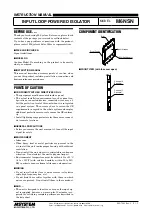
A P P E N D I C E S
page A – 25
WheatNet-IP
/ Apr 2009
page A – 16.9
WheatNet-IP
/ Feb 2010
HP Procurve 2810 Configuration for WheatNet-IP
Overview
Let’s take a look at what needs to be done to get your HP Procurve 2810 switch
ready for the installation of your WheatNet-IP system. Properly configuring your
switch allows you to take advantage of the “management” capabilities to control
network traffic and allows the network to operate at its highest potential. This
becomes necessary to prevent overloading the network as the system size increases.
In this setup process you will setup switch ports according to the type of device
connecting to that port. You will be setting things like VLAN access, Trunking,
Speed, etc. Each section below gives you the exact commands needed to get your
WheatNet-IP network up running.
Below is a chart that gives you some information about the commands you will
be using to complete the setup. This can be a quick reference for you as proceed
through the configuration.
Command
Purpose
Configure Terminal
Enter Global configuration mode on switch
Interface
Enter interface configuration mode
Show running-config
Show the current running configuration
Write memory
Writes the configuration to memory on the switch
IP igmp querier
Enables IGMP querier
This document will explain the initial configuration of the HP Procurve 2810
switch. To get started you will need the HP provided console cable that came with
your switch. Go ahead and connect the console cable to the serial port on your PC and
the RJ-45 to the console port on the lower left corner on the front panel of the switch.
If your PC is not equipped with a serial port you will need a USB to Serial converter.
Next let’s get your PC ready to communicate. You will need a terminal program
such as HyperTerminal to finish this portion of the setup. HyperTerminal is an
application you can use in order to connect your computer to other remote systems.
These systems include other switches, routers, other computers, and Telnet sites.
HyperTerminal is located under the Start menu of your Windows 2000/XP PC.
If you are using Windows Vista or Windows 7 you will need to install a similar
terminal program to complete the setup.
















































